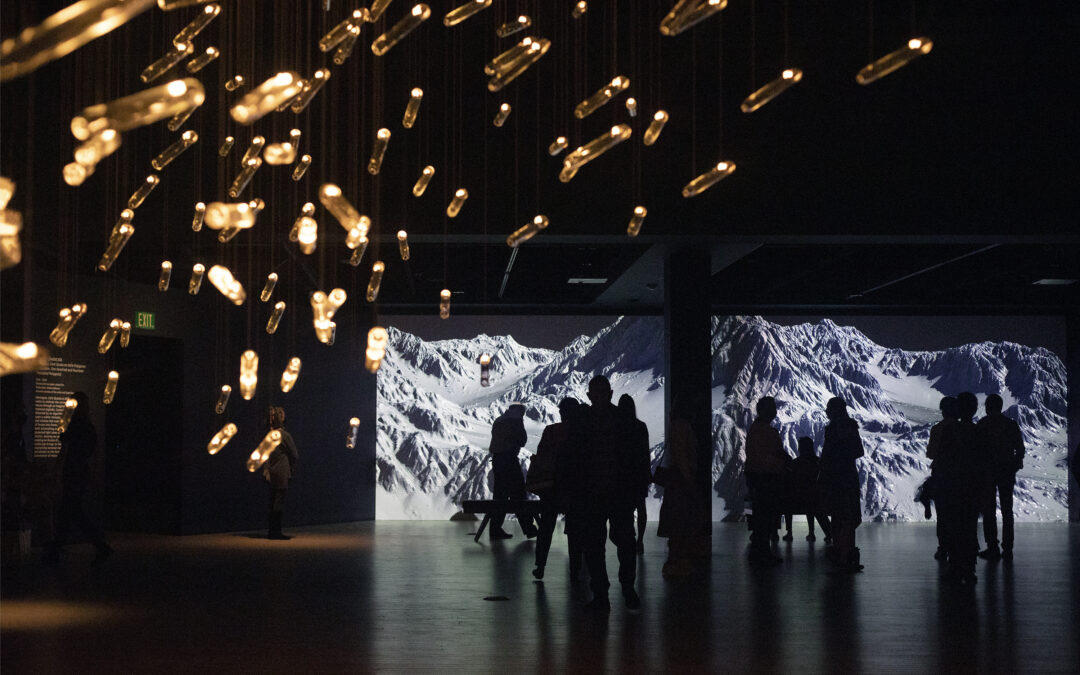By Betsy DiJulio
A sparkling new gem has taken its rightful place on the jewel box campus of Christopher Newport University (CNU). With its cadences of colonnades, pristine pediments, balustraded balconies, and dynamic domes, the campus is a love song to the architectural vocabulary of the Colonial past.
The brand new Torggler Fine Arts Center, with its cascading tiered glass domes, bows graciously in that direction while looking firmly forward. And just as importantly, those daring domes make one want to know what lies inside. The signature facade, said to symbolize the three ships commanded by Christopher Newport in 1606-1607—the Discovery, Godspeed, and Susan Constant—carrying settlers from England for the Virginia Company, form the Rotunda of the museum, a flexible space where visitors are welcomed, not to mention wowed.
Named after Mary M. Torggler who, along with her husband, is a longtime champion and supporter of arts and education programming at CNU, this non-collecting museum’s stated mission is to “Enrich the cultural landscape of the Commonwealth of Virginia by presenting exceptional visual arts programming that empowers creative expression, critical thinking, lifelong learning and cultural dialogue.” And, from all appearances, it is already doing that from the outside in, having garnered prestigious accreditation from the American Association of Museums (AAM) prior to its October 31 public opening.
With a price tag of $60 million—and free admission—the museum’s 83,000 feet offer four galleries on two floors, 5 studio-classrooms, a 150-seat theatre and, on the third floor, CNU’s Department of Fine Art and Art History. The feel of the museum is tailored but luxe thanks to marble floors, rich dark woods, and gold-toned metals, motifs that flow throughout the museum to a greater or lesser degree. Some spaces lean more squarely in the direction of tradition while others favor more contemporary minimalism with natural light flooding the public spaces and studio-classrooms. Coming in 2022 is an interactive Art Explorer’s Gallery and a café. Supply chain issues—namely refrigerators taking a hiatus in Ecuador—have delayed the café’s opening.
Following is a condensed synopsis of the current exhibitions by gallery:
Rotunda
Shylight by Drift (Lonneke Gordijn and Ralph Nauta), 2014, aluminum, polished stainless steel, silk, LEDs, robotics
Night-closing flowers were the inspiration for this kinetic sculpture of nine white blossoms. The natural mechanism that allows day-bloomers to close after dark for self-defense and resource conservation is known as nyctinasty which influenced the technological choreography of these flowers. Each one seems to flirt—shyly at first and then more boldly—descending into the space of visitors only to close and retreat back from whence it came.
Anne Noland Edwards Gallery: Night Light
These immersive, monumental, and largely monochromatic installations were organized by Margot Mottaz, associate curator at Superblue, a groundbreaking new enterprise dedicated to producing, presenting, and engaging the pubic with experiential art. Says executive director Holly Koons about this “intersection of technology and art,” it is intended to “reconnect us more deeply to the natural world.”
Lightweeds by Simon Heijdens, 2005-ongoing, custom software and hardware, computer, projectors, outdoor weather sensor
Responding both to local weather conditions and human interaction in real time, this digital ecosystem of silhouetted flora gracefully and poetically captures the germination and growth patterns of oak trees.
Montagne, Cent Quatorze—Mille Polygones (Mountain, One Hundred and Fourteen Thousand Polygons) by Joanie Lemercier, 2016-2018, digital print on paper, projection
An imagined mountainscape, viewed through a sequence of sunrises and snowstorms, is equal parts art, algorithm, science, and sublimity.
Remains #C_022 by Quayola, 2018, inkjet prints mounted on aluminum
3-D laser scanners capture natural landscapes—five in this installation—at high resolutions, gathering data points that Quayola selects and assembles to compose hybrid formations that are as real as they are unreal: crystalline, frigid, delicate, and infinite.
Eye Witness and Black Forest by Michal Rovner, 2016, LCD screen and video
These black and white slow-motion video portraits of golden jackals feel voyeuristic in the way that wildlife cameras reveal a private nocturnal world in which the line between the seer and the seen is fraught with eerie tension and sociopolitical analogies.
Flylight by DRIFT (Lonneke Gordijn and Ralph Nauta), 2009, glass, wire, electronics, halogen lights, anodized aluminum
Birds in flight, specifically starling murmuration, is the subject of this site-specific installation that calls to mind the paradox between a desire for individual freedom and the benefits accorded to members of a collective. The lights in the suspended blown glass tubes respond in real time to visitor movement, swarming or returning to a passive state upon realizing they are not being hunted, thus serving as a metaphor for the quest for equilibrium between autonomy and integration.
William M. Grace Community Gallery
Nocturne
Local and regional artists with strong name recognition—like James Warwick Jones and Nicole Santiago—make up this exhibition with work encompassing a variety of subjects depicted at twilight or night. Photographs by the gallery’s eponym, Bill Grace, founder and CEO of Grace Industries in Newport News, are also included.
Academic Gallery
ArtCNU Alumni Exhibition 2021
Dedicated to CNU students, faculty, and alumni, this gallery’s opening exhibition is an alumni invitational featuring diverse work by 15 former students who graduated between 1996 and 2021. Any university would be proud to call their own the creators of this professional and high caliber work.
Microgallery
Ryan Lytle: What It Means to be a Fox
The first of what will be ongoing experimental projects in a range of media on an intimate scale, Lytle’s needle-felted sculptural and painted installation explores the role of the fox in folklore and mythology. As he says, his work depicts animals but is about humans. Lytle, a Richmond-based artist and adjunct professor at CNU, feels that foxes, as tricksters who “play with the laws of the universe,” share much in common with artists, for both exist to raise questions. Here a mature fox engages in a mystical exchange of knowledge with a younger member of the species.
Mary M. Torggler Fine Arts Center, www.thetorggler.org, 1 Avenue of the Arts, Newport News, 757.594.0800




